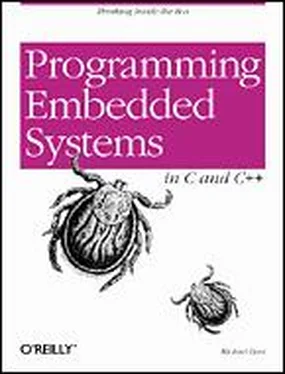Most of the debugging tools described in this chapter will be used at some point or another in every embedded project. Oscilloscopes and logic analyzers are most often used to debug hardware problems — simulators during early stages of the software development, and debug monitors and emulators during the actual software debugging. To be most effective, you should understand what each tool is for and when and where to apply it for the greatest impact.
Chapter 5. Getting to Know the Hardware
hardwaren. The part of a computer system that can be kicked.
As an embedded software engineer, you'll have the opportunity to work with many different pieces of hardware in your career. In this chapter, I will teach you a simple procedure that I use to familiarize myself with any new board. In the process, I'll guide you through the creation of a header file that describes the board's most important features and a piece of software that initializes the hardware to a known state.
5.1 Understand the Big Picture
Before writing software for an embedded system, you must first be familiar with the hardware on which it will run. At first, you just need to understand the general operation of the system. You do not need to understand every little detail of the hardware; that kind of knowledge will not be needed right away and will come with time.
Whenever you receive a new board, you should take some time to read whatever documents have been provided with it. If the board is an off-the-shelf product, it might arrive with a "User's Guide" or "Programmer's Manual" that has been written with the software developer in mind. However, if the board was custom designed for your project, the documentation might be more cryptic or written mainly for the reference of the hardware designers. Either way, this is the single best place for you to start.
While you are reading the documentation, set the board itself aside. This will help you to focus on the big picture. There will be plenty of time to examine the actual board more closely when you have finished reading. Before picking up the board, you should be able to answer two basic questions about it:
• What is the overall purpose of the board?
• How does data flow through it?
For example, imagine that you are a member of a modem design team. You are a software developer who has just received an early prototype board from the hardware designers. Because you are already familiar with modems, the overall purpose of the board and the data-flow through it should be fairly obvious to you. The purpose of the board is to send and receive digital data over an analog telephone line. The hardware reads digital data from one set of electrical connections and writes an analog version of the data to an attached telephone line. Data also flows in the opposite direction, when analog data is read from the telephone line jack and output digitally.
Though the purpose of most systems is fairly obvious, the flow of the data might not be. I often find that a data-flow diagram is helpful in achieving rapid comprehension. If you are lucky, the documentation provided with your hardware will contain a superset of the block diagram you need. However, you might still find it useful to create your own data-flow diagram. That way, you can leave out those hardware components that are unrelated to the basic flow of data through the system.
In the case of the Arcom board, the hardware was not designed with a particular application in mind. So for the remainder of this chapter, we'll have to imagine that it does have a purpose. We shall assume the board was designed for use as a printer-sharing device. A printer-sharing device allows two computers to share a single printer. The user of the device connects one computer to each serial port and a printer to the parallel port. Both computers can then send documents to the printer, though only one of them can do so at a given time.
In order to illustrate the flow of data through the printer-sharing device, I've drawn the diagram in Figure 5-1. (Only those hardware devices that are involved in this application of the Arcom board are shown.) By looking at the block diagram, you should be able to quickly visualize the flow of the data through the system. Data to be printed is accepted from either serial port, held in RAM until the printer is ready for more data, and delivered to the printer via the parallel port. The software that makes all of this happen is stored in ROM.
Figure 5-1. Data-flow diagram for the printer-sharing device
Once you've created a block diagram, don't just crumple it up and throw it away. You should instead put it where you can refer to it throughout the project. I recommend creating a project notebook or binder, with this data-flow diagram on the first page. As you continue working with this piece of hardware, write down everything you learn about it in your notebook. You might also want to keep notes about the software design and implementation. A project notebook is valuable not only while you are developing the software, but also once the project is complete. You will appreciate the extra effort you put into keeping a notebook when you need to make changes to your software, or work with similar hardware, months or years later.
If you still have any big-picture questions after reading the hardware documents, ask a hardware engineer for some help. If you don't already know the hardware's designer, take a few minutes to introduce yourself. If you have some time, take him out to lunch or buy him a beer after work. (You don't even have to talk about the project the whole time!) I have found that many software engineers have difficulty communicating with hardware engineers, and vice versa. In embedded systems development, it is especially important that the hardware and software teams be able to communicate with one another.
5.2 Examine the Landscape
It is often useful to put yourself in the processor's shoes for a while. After all, the processor is only going to do what you ultimately instruct it to do with your software. Imagine what it is like to be the processor: what does the processor's world look like? If you think about it from this perspective, one thing you quickly realize is that the processor has a lot of compatriots. These are the other pieces of hardware on the board, with which the processor can communicate directly. In this section you will learn to recognize their names and addresses.
The first thing to notice is that there are two basic types: memories and peripherals. Obviously, memories are for data and code storage and retrieval. But you might be wondering what the peripherals are. These are specialized hardware devices that either coordinate interaction with the outside world (I/O) or perform a specific hardware function. For example, two of the most common peripherals in embedded systems are serial ports and timers. The former is an I/O device, and the latter is basically just a counter.
Members of Intel's 80x86 and some other processor families have two distinct address spaces through which they can communicate with these memories and peripherals. The first address space is called the memory space and is intended mainly for memory devices; the second is reserved exclusively for peripherals and is called the I/O space. However, peripherals can also be located within the memory space, at the discretion of the hardware designer. When that happens, we say that those peripherals are memory-mapped.
from the processor's point of view, memory-mapped peripherals look and act very much like memory devices. However, the function of a peripheral is obviously quite different from that of a memory. Instead of simply storing the data that is provided to it, a peripheral might instead interpret it as a command or as data to be processed in some way. If peripherals are located within the memory space, we say that the system has memory-mapped I/O.
Читать дальше












